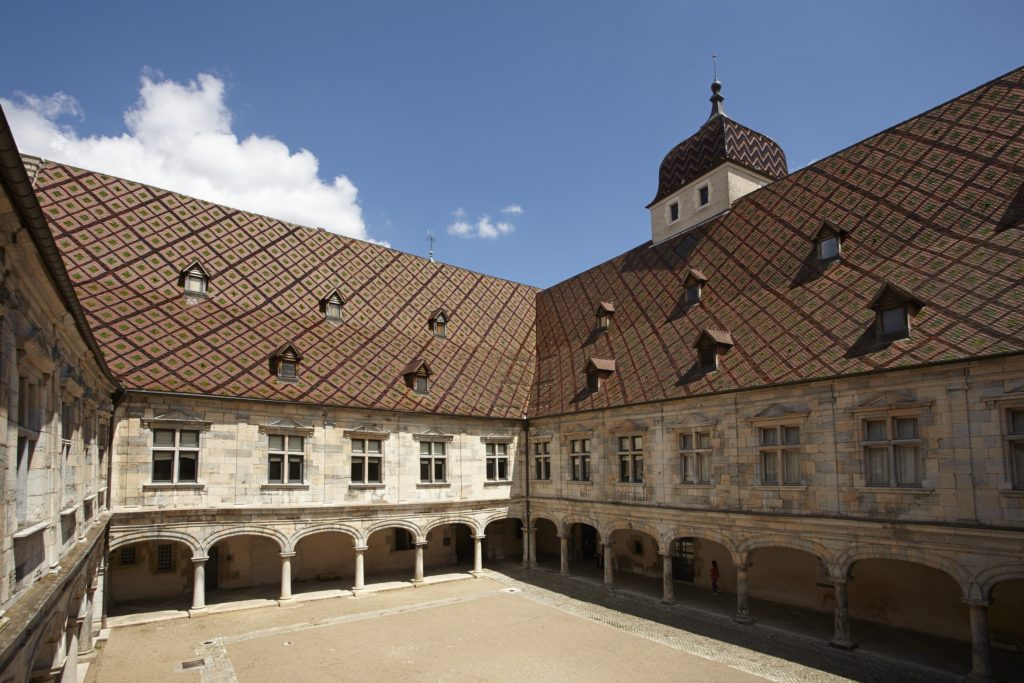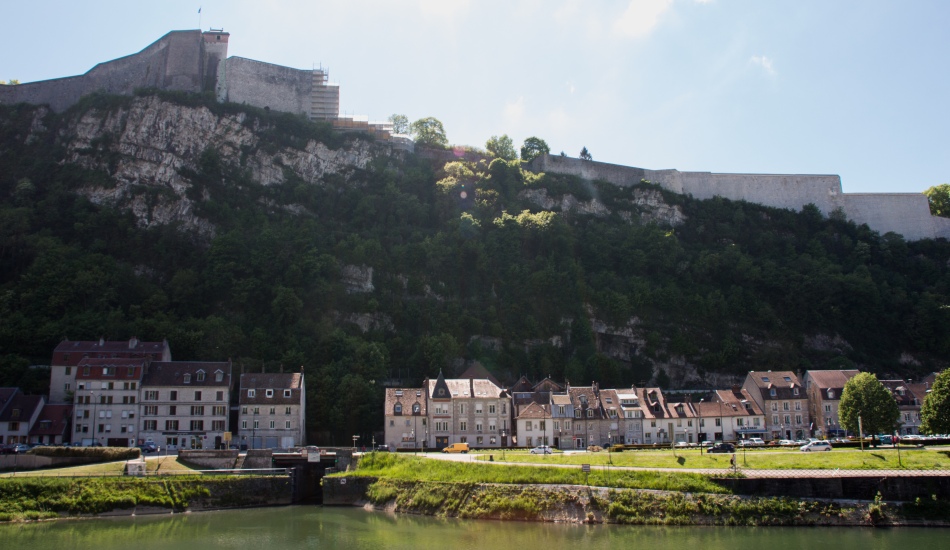Besançon is the laid-back capital of the Franche-Comté region. A wander through ‘La Boucle’—the old town nestled in the loop of the river Doubs—uncovers ancient houses, 17th century Spanish-style stone mansions, monuments to Victor Hugo, and the architectural gift of King Louis XIV and UNESCO World Heritage Site: Vauban’s Citadel.

View of the Doubs from the Citadel (Photo: Emmanuel Fromm via Flickr)
Borderlands are often places of transition and Besançon is no exception. The city combines Roman ruins, French culinary heritage, Spanish touches, and the emerald green fields, sloping hills, and local cheese reminiscent of Switzerland, to create something that is uniquely Besantin.
Numerous periods of history are on show during a walk through the city, like the Roman-era theatre, Spanish-style stone mansions from the period during which Besançon was a fief of the Habsburg empire, and the imposing fortress built by renowned military engineer Sébastien Le Prestre de Vauban. A waterfront promenade along Quai Vauban on the Doubs Riverside highlights the arcaded docks, lined with restaurants, as well as the limestone buildings from the Renaissance period.
Exploring on foot is the best way to see the little nooks and crannies of the historic old town. You’re likely to come upon the Besançon’s most important museum, Musée des Beaux-Arts et d’Archéologie (1 Place de la Révolution). It’s one of the oldest art galleries in France. Standing in the old market square, it hosts a rich collection of paintings, sculptures, and historical artifacts. The museum reopened in November 2018 after a thorough renovation.

Museum of Time courtyard (Photo: Pierre Guenat)
The Museum of Time (96 Grande Rue) is potentially more quintessentially Besantin, considering the city revolves around time: Besançon is considered the watch capital of France. Housed in the Renaissance Granvelle Palace, built for the Hapsburg Emperor Charles V, is a collection of the original 17th-century Bruges tapestries. This museum documents the historical journey of measuring time, thus the museum is filled with sundials, hourglasses, watches, and clocks: grandfather and cuckoo included.
Touring the museum is good preparation for seeing the city’s famous astronomical clock (Rue du Chapitre) built by Auguste-Lucien Vérité in the 19th century. The clock is housed inside the medieval St. Jean Cathedral, home the works of several Florentine Renaissance painters and stained glass windows that leave you awash with colour. However, the clock steals the show: with 30,000 moving parts and 122 measures of times, dates, seasons, solstices and more, it’s truly a feat of clock making.

The inner workings of Besancon’s astronomical clock (Photo: Valentin R. via Flickr)
The Birthplace of Victor Hugo (140 Grande Rue) is a small but interesting museum dedicated to the author’s political and literary life. The old townhouse showcases his enlightened opinions in regards to the rights of women, children and the poor. The museum connects a lot of his work to the present day—particularly in relation to freedom of the press. Often there is a tour with a guide, included in the cost of entry. Just next door is a historic pharmacy, with its original floors and apothecary jars.
The city centre is also a starting point of several well-marked hiking trails to the hills and valleys of the Jura surrounding the city. If a hike isn’t on the itinerary, walk up to the UNESCO Heritage Citadel. While an important historic monument in its own right, the Citadel also houses a folk museum, the Museum of the Resistance and Deportation, an insectarium, and a zoo. The Museum of Resistance relates the tales of World War II, and exhibits some stirring art works made by prisoners of concentration camps during their imprisonment.

The Citadel and the Rivotte Quarter (Photo: Doubs Tourisme/Elodie Faivre)
Accommodation
For a small city, Besançon offers many accommodation possibilities: from restful villas near the park, charming hotels in the heart of the old town, to guest houses in the countryside.
The chic Hotel de Paris (33 Rue des Granges) in the centre of Besançon offers a variety of rooms, from cozy and functional to grand and traditional. The hotel dates back to the 18th century when it was a coaching inn for weary travellers—today, the décor has managed to marry that tradition with contemporary style. Continental breakfasts are served in the dining room or terrace.

Dining room at Hôtel de Paris (Photo: Hôtel de Paris via Facebook)
The newly renovated Villa Molina (12 Chemin Français), covered in wisteria and surrounded by greenery, is great if you want some independence and serenity away from the busy centre. The villa features modern rooms with soft hues, a lovely private bathroom and cozy living room. The hosts, Mr. Macé and his family, offer an indulgent breakfast—which, when the weather is nice, you can eat in the garden.
See the other side of Besançon at the three-star Hôtel Foch (7 Avenue du Maréchal Foch). Just around the corner from the Viotte train station is this no-nonsense accommodation with easy access to the city centre. This hotel’s cozy rooms offer views of the Old Town from across the river and it is an easy walk to Fort Griffon from there. Rooms feature a private bathroom, television, and free Wi-Fi.
Restaurants, Bars & Cafés
From pungent regional Comté cheeses to local smoked ham, Besantin cuisine is hearty and worth trying. Specialities of Besançon featuring ingredients like vin jaune, morille mushrooms, and Comté cheese are harder to find outside of the region.
Restaurant 1802 (Place Granvelle) is a romantic venue featuring large glass windows and an outdoor terrace near the Museum of Time. They serve a contemporary version of France’s national cuisine, with attentive waiters. Unlike other venues, Restaurant 1802 also does an excellent job of catering for vegetarian diners. Ask a waiter for suggestions of wines to pair with certain meals or digestifs (fir tree liquor) after dinner. Chef Matthieu Engel ensures seasonal dishes, with ingredients sourced locally.

Cozy drinks at dining at Restaurant 1802 (Photo: Restaurant 1802)
If family-run, local specialities are what you’re looking for, Le Poker d’As (14 Rue du Clos Saint-Amour) offers fine interpretations of traditional, regional cuisine. The interiors are reminiscent of the Jura, featuring a dining room decorated with wood and cowbells. They specialize in Franche-Comté cuisine, so this is the place to try chicken in vin jaune with morel mushrooms, goumeau a franc-comtoise flat cake, and the original AOC wine: Arbois.
For good vibes and nice beer, head to Brasserie Chill Out Bar (4 Rue Bersot) in the centre of the city. The offerings are a bit motley—Spanish tapas, Caribbean reggae, and German beer—but somehow it all comes together for a laid-back place to sip an aperitif before a late meal.
Beef tartare and Franc-comtoise salad, and the regional chicken in vin jaune and morel mushrooms are the anchors of Brasserie du Commerce’s (31 Rue des Granges) menu. This restaurant calls a historic location home: Besantins have been enjoying meals here since 1873, so you might want to book well in advance. Be sure to enjoy their decadent café/thé gourmand: a selection of their best desserts petits fours served with tea or coffee.
For something casual by the Doubs riverbend, check out L’Alsacien (2 Quai Vauban) on the Battant Bridge. They serve everything to tradition, from their flammekueches to Alsatian salad. The flammekueches have a nice flaky crust, with a variety of toppings and the Alsatian salad comes with sliced cervelas sausage. The riverbank location is what makes it a favourite, overlooking the Doubs from Quai Vauban.

Quai across Pont Battant at night (Photo: Denis Bringard)
Vegans and vegetarians tend to visit the cool and cozy ÖST café on the other side of the river. Here, good coffee, fresh juice, and healthy breakfasts are available. On the weekends, they offer a vegetarian brunch menu in their modern, stylish spot filled with hipsters and students throughout the day.
Shopping
At just an hour and a half’s drive from Neuchatel, Besançon sees a influx of Swiss residents travelling to do their shopping. Though it’s easy to find a deal at one of the many high street stores, Besançon’s independent boutiques and ateliers make it a place worth driving to.
Master chocolatier Fabrice Gillotte (59 Rue des Granges) has a workshop in Besançon, at the forefront of international handmade chocolate making. He was awarded the prestigious, coveted Meilleur Ouvrier de France (Best Artisan of France) award in the choclatier category. Be advised, they close in the summer due to the heat and people don’t mind—excellence and quality have no time limits.

Inside the shop of Fabrice Gillotte (Photo: Fabrice Gillotte via Facebook)
When it comes to cheese, the family-run Cave aux Fromages (2 Rue Gustave Courbet) has you covered. The shop has been around since 1850. The cluttered little shop in market square offers up a variety of young and old comté cheeses, along with a selection of wines, liqueurs, and gourmandises from the Jura.
Moving on from the tasty treats of Franche-Comtois, recall that watchmaking is Besançon’s main claim to fame. Head to UTINAM on Avenue de Chardonnet for contemporary timepieces with traditional mechanisms. The clocks and watches are 100% made in the region: Utinam is the city’s motto meaning: “God willing”.

Behind the scenes at UTINAM (Photo: UTINAM via Facebook)
Travellers looking for ways to minimize their environmental impact while they travel will be pleased to know they can stop at Le Vrac (90 Rue des Granges), Besançon’s packaging-free grocery store. They sell more than food, including cute re-usable containers, bags, and more.
When you’re looking for a gift with that je ne sais quoi, head to La Petite Bohème (23 Rue Bersot), a concept store for the young and the young-at-heart. From women’s fashion and baby-shower gifts to dainty jewellery and unique home accessories, it’s a whimsical little boutique that deserves a browse.